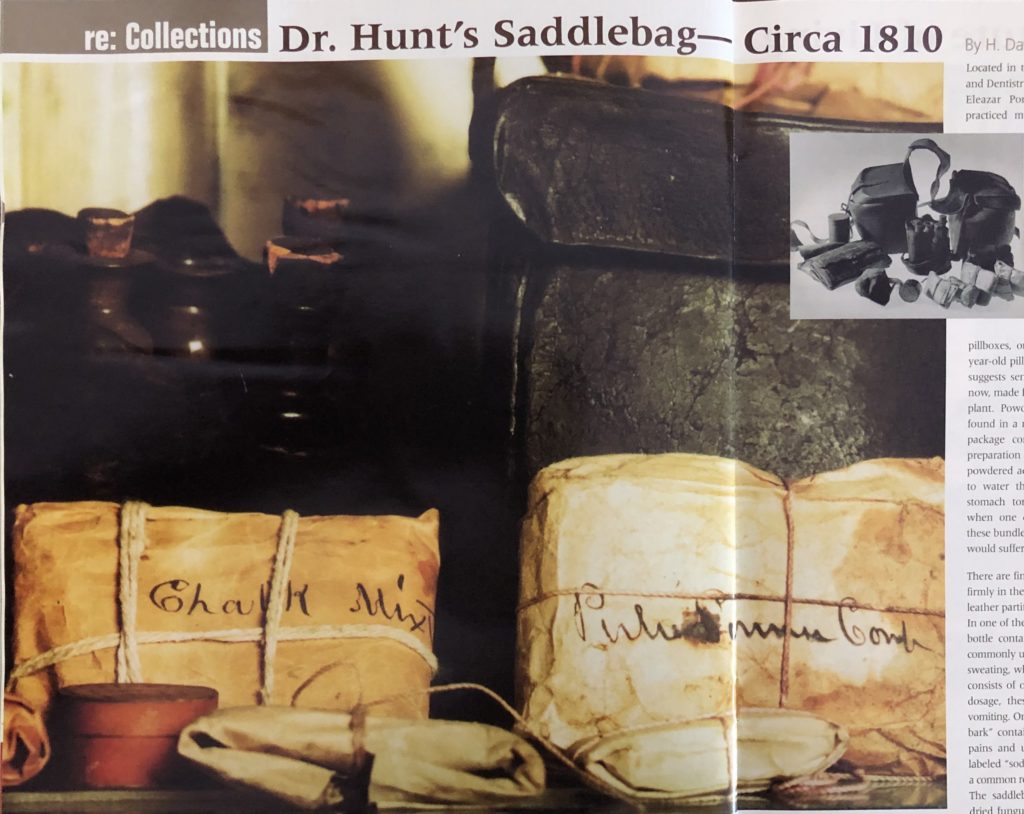
Detail of Dr. Eleazar Hunt’s saddlebag. left packet contains “chalk mix”; right packet reads: Pulvis Sennae Comp(ositus), Latin for powdered compound of Senna. photo: Tim Conlin; inset: Dr. Hunt’s saddlebag and contents. photo: Marc B. Sitkin. Menczer Museum of Medicine and Dentistry, Hartford Medical Society
By H. David Crombie, M.D.
(c) Connecticut Explored Inc. Feb/Mar/Apr 2004
Subscribe/Buy the Issue!
Located in the Menczer Museum of Medicine and Dentistry in Hartford (now closed) is the saddlebag of Dr. Eleazer Pomeroy Hunt (1786 – 1867), who practiced medicine in an era when doctors conducted most of their professional activity in the homes of their patients. Travel to the patients took place on horseback, and while the doctor of today might shudder at the thought of his forbears’ stormy winter rides, the contemplative time in fair weather, on a mission to comfort, stands in sharp contrast to the frenetic pace of present day office and travel hours.
This saddlebag contains wooden pillboxes, one of which still holds a few 200-year-old pills prepared by Dr. Hunt. Their color suggests senna, a popular purgative then and now, made from the ground leaves of the senna plant. Powdered compound of Senna is also found in a neatly tied paper package. Another package contains “chalk mix,” a powdered preparation containing chalk (a calcium salt), powdered acacia, sugar, and cinnamon. Added to water this was used as an antacid or a stomach tonic. The tying seems appropriate when one considers the amount of shaking these bundles of dried and powdered botanicals would suffer over miles of travel on horseback.
There are finger-like glass medicine bottles held firmly in their own leather case with well-fitted leather partitions to prevent breakage in transit. In one of the slots is a hand-blown smaller glass bottle containing Dover’s powder. This was a commonly used pain reliever that also promoted sweating, when this was deemed therapeutic. It consists of opium and ipecac. Ipecac in larger dosage, these days in syrup form, stimulates vomiting. One tied package is labeled “chinchona bark” containing quinine for muscle and joint pains and used to treat malaria. Another is labeled “soda” presumably bicarbonate of soda, a common remedy for gastrointestinal complaints. The saddlebag also contains ergot powder, a dried fungus found on grain used to stimulate muscle contraction. Though not found within the bag, an apothecary scale and a set of weights would have been essential for Dr. Hunt in compounding the various botanicals in the home.
Contemporary doctors and patients must make a historical leap from the miracles of modern medicine to appreciate a time when there were few cures. Each doctor, trained as an apprentice in the favorite botanicals of his mentor in materia medica, carried his own apothecary from house to house and dispensed botanicals to relieve symptoms. We know now that when the patient turned the corner and got well it was more the result of the human body’s remarkable resilience and reserves than anything attributable to the various plant extracts. Dr. E. P. Hunt’s saddlebag, handed down through 200 years, assists in that appreciation.
EXPLORE!
“Doctoring on the Field of Battle,” Dr. Nathan Mayer’s Civil War experiences, Spring 2007
Read more stories about health history in Connecticut in the Feb/Mar/Apr 2004 and Spring 2007 issues and on our Health & Medicine TOPICS page.
Dr. E. P. Hunt’s saddlebag was on view at the Menczer Museum of Medicine and Dentistry, 230 Scarborough Street, Hartford, Connecticut. The museum is no longer operating.
The author is indebted to Diane N. Hernsdorf, Executive Director of the Hartford Medical Society, its library and Menczer Museum of Medicine and Dentistry, for her kind assistance in the preparation of this piece. Dr. H. David Crombie is a senior surgeon at Hartford Hospital and immediate past president of the Hartford Medical Society. His avocation throughout his career has been the study of regional and medical history.
